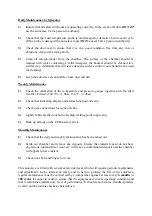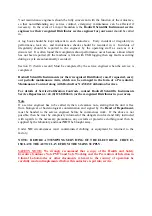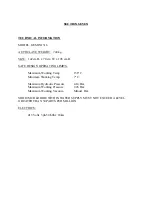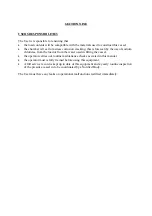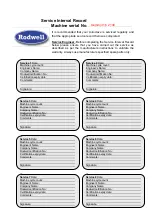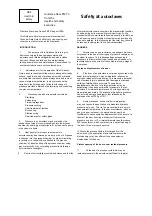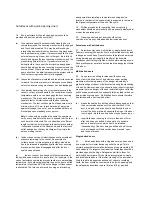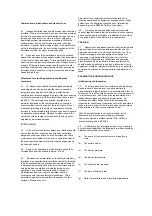
Autoclaves
with
quick
‐
opening
doors
18
Every autoclave with quick opening doors should be
provided with devices which ensure that:
(a)
the autoclave cannot be pressurlsed unless the door is
completely closed, the securing mechanism fully engaged
and the chamber sealed. This may be achieved by an
interlocking device between the door securing mechanism
and the pressurising system. If pressure is applied from an
external source, eg steam, air or other gas, the interlock
should be between the door securing mechanism and the
pressurising fluid inlet valve. If pressure is raised by
boiling liquid in the vessel, the interlocking arrangement
should be between the door securing mechanism and the
source of heat. Where pressure is applied by a pump, the
pump should not be able to pressurise the system unless
the door securing mechanism is fully engaged;
(b) the source of pressure is isolated and the autoclave vented
to reduce the internal pressure to atmospheric conditions
before the door securing mechanism can be disengaged;
(c) the operator has warning of any residual pressure in the
vessel or of any process liquid in the vessel at an unsafe
temperature before he can disengage the door securing
mechanism. This may be achieved by providing a
separate test cock interlocked with the door securing
mechanism. The test cock should be of adequate size (a
minimum bore of 12 mm is recommended), protected
against blockage, (see note), and so positioned that any
discharge does not endanger any person.
Note:
A
rod should be provided to enable the operator to
verify, every time before the door is opened, that the test
cock bore is not blocked. The rod should be of sufficient
length to clear the bore through to the autoclave chamber.
It should be cranked at the handle end, and the test cock
outlet arranged so that any discharge will not injure the
person making the test.
(d) the door does not open violently because of any residual
pressure remaining in the vessel. An example of a
suitable device for this purpose is a safety catch which
has to be released independently after the door securing
mechanism has been disengaged and after the door
seal has been broken.
(e)
the door cannot be opened until the temperature of
the liquid has been reduced to a safe level. For example, in the
case of autoclaves containing process liquid at or near scalding
temperature, it should not be possible to open the door until the
temperature is less than 80
0
C when the danger of flash vapour
is eliminated. That may be achieved by using an interlocking
arrangement incorporating a temperature sensing device
located in that part of the vessel which is expected to remain at
the highest temperature at the end of the cycle.
19 Written procedures for operating the door securing
mechanism should be permanently and prominently displayed at
or near the operating point.
20 Opening and closing of doors should only be
carried out by properly trained and authorised personnel.
Autoclaves with bolted doors
21 Autoclaves may have multi-bolted or single-bolted doors.
Failure to secure all the door bolts of a multi-bolted door may lead
to dangerous conditions. Operators should therefore be warned
during training and periodically thereafter of the possible
consequences of failing to tighten all bolts before starting a cycle.
Such practices may save time but can lead to a dangerous failure
of the door.
Multi-bolted doors
22 An operator is unlikely to release all the securing
bolts of a multi-bolted door of an autoclave under working
pressure without being aware of the danger indicated by a
gradual leakage of vapour or fluid contents during the slackening
of the bolts. However, when the vessel is under slight or residual
pressure there is a danger of the door seal sticking even after the
bolts have been removed; consequently this may lead to the door
being violently blown open. Multi-bolted doors should therefore
be provided with a device which either:
(a) breaks the seal
before
all the bolts are disengaged. so that
the door remains captive until the seal is broken. If the
door is hinged, the device should be attached to one or
more of the bolts. preferably opposite the hinge. If the door
is not hinged, more than one device may be necessary; or
(b) restricts the door opening to not more than about 5mm
after it has been unbolted. An example of a suitable
device is a safety catch which has to be released
independently of the door being unbolted and which may
not be released until the door has been 'cracked' open
and the seal broken.
Single bolted doors
23
Small autoclaves with a hinged door may be secured
by a single bolt or similar device opposite the hinge. This is
normally acceptable for small autoclaves up to approximately 50
Iitres capacity. On larger units at least two fastenings should be
provided opposite the hinge. Safeguards similar to those for
multi-bolted doors (para 22) should be incorporated on single
and double bolted doors. If the initial 'cracking' of the door seal is
likely to lead to a dangerous emission of vapour or scalding
liquid, the door should be considered to be 'quick-opening' and
the safeguards described in para 18(b) and 18(c) provided.


